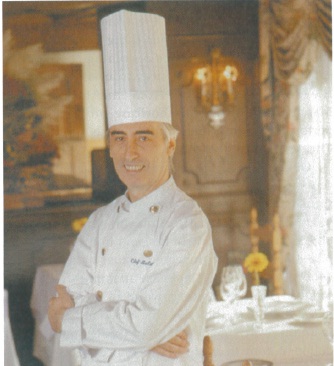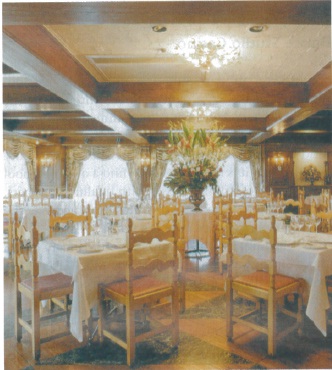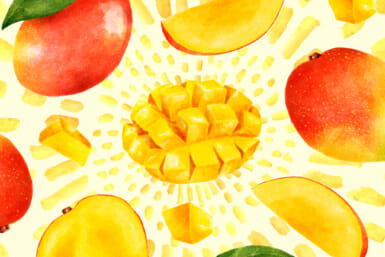Experience Italy with a gorgeous, old friend
by Christine Cunanan-Miki
To many long-time Tokyoites, Ristorante Sabatini di Firenze (RSF from hereon) is a well-loved dining institution that can trace its beginnings 25 years ago to a time in Japan when culinary choices were simpler and only a handful of non-Japanese restaurants reigned supreme. In those days, RSF’s solid, old-fashioned dishes were among the few that could really be called ‘Italian.’ The alternatives were the overcooked spaghetti with meatballs or soupy carbonara served in practically every other Western-style restaurant in town. So naturally everyone trooped to Ginza for a proper Italian meal at RSF.
I was reminded of this as my husband and I were ushered to our table at RSF one recent evening, and he said: “My first boss used to take me here. This was also where we used to have our company Christmas dinners.” Of course, I wasn’t about to allow him to monopolize the reminiscing. “Well, when I was a young diplomat, I used to come here all the time,” I countered. “This was where we used to discuss national policies and state visits.” RSF is that kind of place — so much so that almost anyone who was here in the swing of things in the 80s will have a memory of it.
Surveying our surroundings in 2006, it seemed like nothing much had changed since then. But then again, why change something that obviously works? RSF has been making culinary waves since 1981 and even today, when Tokyo is awash with so many good Italian restaurants, it is still a barometer of excellent Italian cooking for gourmet and gourmand alike.
The restaurant itself, with its fancy window treatments, red-and-black marble floors, exposed wooden beams and trademark provincial chairs (which are the same chairs used in the original Ristorante Sabatini in Florence), made us temporarily forget that we were on top of the Sony building an entire world away from the banks of the River Arno. And even executive chef Virgilio Baldi, who was born in the picturesque Tuscan town of Lucca, has been presiding over RSF’s kitchens since its first days.
Being a true Tuscan, Chef Baldi is at his best with traditional specialties like filleto di manzo (beef sirloin) with various sauces or ossobuco (stewed leg of veal). Happily, however, he has changed these slightly to suit Japanese tastes so that most of his dishes are neither portioned too large nor seasoned too heavily as is often the case in that part of Italy.
After living in Japan for so long, Chef Baldi has also incorporated some local ingredients into his cooking and with lip-smacking results. I was completely won over by his starter of green salad topped with smoked eel and a yuzu (Japanese lemon) dressing (Anguilla affumicata, vinegrette alio yuzu), and his take on grilled sirloin, which paired Japanese beef (which is fattier and sweeter than Italian beef) with aged balsamic vinegar for a fine balance of meat sweetness and vinegar sharpness.
“Some people feel I shouldn’t use Japanese beef for this,” he revealed. “But others like it a lot.” Well, I’m certainly part of the appreciative camp.
Appropriately, the service at RSF is very Old World as well. Everyone is polite and discrete but no one falls over themselves to pamper you and sometimes they’ll forget to refill your water glass or bring biscuits with coffee — just like at many formidable ristorante in Italy with years, if not centuries, of history behind them. With great food and authentic service like this, who needs a trip to Italy?
WHAT TO EAT
Until the end of February, RSF is offering an anniversary dinner iiumi to commemorate its 25 years in Tokyo. This six-course dinner featuring the best of Tuscany costs ¥11,000 per person — a not unreasonable price for a fancy Ginza dinner. At other times, Chel Bardi can make a risotto with your choice of ingredients (it takes 20 minutes and prices start from ¥2,300 per plate) and I suggest you request one with Pecorino cheese and special ham from Sienna (Risotto con fonduta di Pecortno Toscana e Cintasenese). For main courses, forget seafood since you are in a Florentine restaurant and go for Chef Bardi’s specialties: beef sirloin with rucola and aged balsamic vinegar (Tagliata di Manzo Alla Rucola e Aceto Balsamico, ¥8,000) or beef fillet with goose liver and black truffle sauce (Filetto di Manzo con Fegato Grasso e Salsa al Tartufo Nero).
WHAT TO DRINK
Start the evening with an authentic Tuscan white. The slightly acidic 2003 Vernaccia di San Gimignano (¥1,300 per glass) goes well with appetizers and most pasta. To accompany your main course, we found a surprisingly reasonable well-balanced red called Chianti Colli Senesi 2003 (¥6,000 per bottle) that proved very satisfying with meat.
WHERE TO SIT
The window tables that look out onto Ginza’s Sukiyabashi crossing are the most popular. Restaurant manager Tsutomu Muroi says some people even book these up to a month in advance.
HOW MUCH DID IT COST
A dinner course for two with wine will cost upwards of ¥30,000, including a 12% service charge.
WHO GOES I HERE?
We were there at 7pm on a Wednesday and the restaurant was packed and lively with an eclectic mix of couples of all ages and several groups of businessmen.
Sony Bldg. 7F Ginza 5-3-1, Chuo-ku, Tokyo Tel. 03-3573-0013
www.miyoshi-grp.com/cardinal/sabatini/










